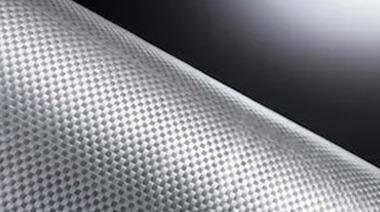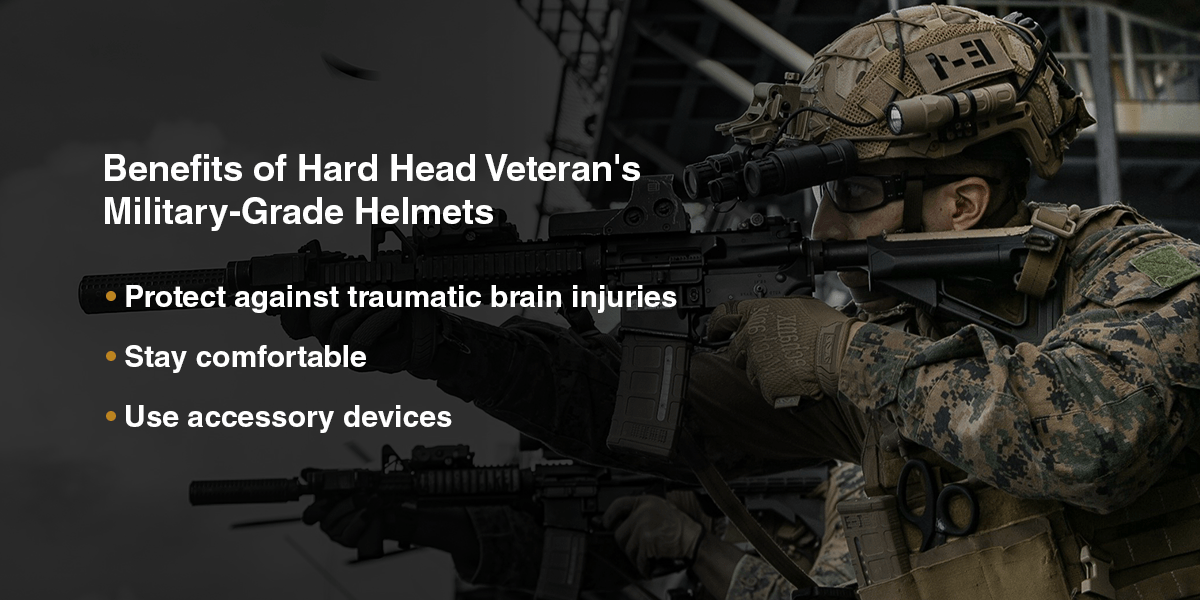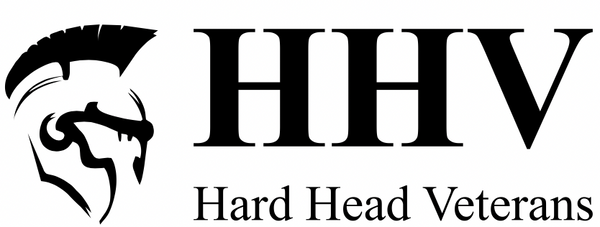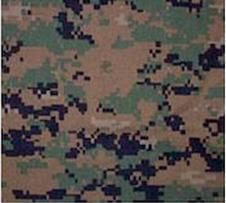Military Kevlar helmets with modern designs from Hard Head Veterans can provide military personnel with the head protection they need while also offering comfort and convenience. From low-cut ballistic helmets to various helmet accessories, we provide safety gear options for those in the military and beyond. Here's a look at different types of modern military helmets, equipment and more.
Military combat helmets come in numerous types, generations, and features. Such as older PASGT helmets to next generation ATE (above the ear) type tactical helmets. In this article you will learn the main different types of ballistic helmets, what they are made of, and the features they may have!
Types of Modern Military Helmets
U.S. military helmets have come a long way since the invention of the M1917, first used in World War I. This helmet was made from a manganese-steel alloy shell that provided minimal protection. With each new helmet design, warfighters have benefited from improvements in form and function. In 1936, the M1917A1, or "Kelly," helmet came out — and then in 1941, the M1 helmet emerged onto the scene.
In the 1970s, the well-known Personnel Armor System Ground Troops (PASGT) helmet was introduced, made from the newly developed material Kevlar. This style of helmet, also sometimes called a "K-Pot," remained standard issue for decades and is still in use today. In the early 2000s, the military upgraded once again with the Modular Integrated Communications Helmet (MICH) and the Advanced Combat Helmet (ACH).
These helmets continue to evolve to meet the demands of modern soldiers. Some of the newest styles are known as Enhanced Combat Helmets (ECH). New military helmets from Hard Head Veterans feature contemporary designs and quality materials to keep military personnel safe. Choose from two styles of ballistic helmets and a military bump helmet:
1. Low-Cut Ballistic Helmets for the Military
The BTE® Ballistic Helmet is a low-cut MICH- or ECH-style helmet. The low cut means this helmet comes down on the sides to cover the ears. That extra coverage is helpful in some scenarios, and while the additional material of low-cut styles can mean extra weight, our helmet's DuPont™ Kevlar® shell keeps the weight as low as possible.
Both the modular design of these helmets and the adjustable memory foam inside make it easy to tailor each helmet to the soldier that puts it on so you get a comfortable fit every time.
2. High-Cut Ballistic Helmets for the Military
We also offer the HHV ATE® GEN2 Ballistic Helmet, which features an above-the-ear (ATE) design. Also known as a high-cut design, these helmets are more open on the sides to leave the ears exposed. This design feature was first intended for maritime special operations but has proved to be beneficial in various applications. ATE styles are ideal when soldiers need to wear a headset, as the helmet doesn't interfere with that accessory.
These helmets do more than just stay out of the way of a headset — they actually make it easy to integrate the headset via a rail mounting system. You can also mount other accessories such as lights or cameras for tactical operations.
3. Bump Helmets for the Military
The low- and high-cut helmets above are military bulletproof helmets. There are also military-grade helmets that are lighter and designed for blunt impacts that could cause a head injury. These helmets, such as the Tactical Helmet ATE® Bump from Hard Head Veterans, are known as bump helmets.
These helmets are ideal when weight is a factor especially if you need to mount NVG’s. They're also helpful during search and rescue efforts when natural hazards such as falling rocks are present. Keep in mind that these helmets aren't rated for ballistic impacts.
What Is A PASGT Helmet?
PASGT stands for Personnel Armor System for Ground Troops and is pronounced as “pass-GET.” These tactical helmets were used by the United States military from the early years of the 1980s to the middle of the 2000s. They are typically made of Aramid Kevlar Fibers. Sometimes referred to as a K-pot or kevlar helmet. Their most defining feature is a lip over the brow of the helmet. These combat helmets are still in use today, some utilizing original fiber technology, while others featuring upgraded combat pads and fibers.


What Is A MICH Or ACH Helmet?
The Modular Integrated Communications Helmet or the MICH was developed as an improvement on the PASGT while the ACH or the Advanced Combat Helmet is an advanced version of the MICH. Militaries around the world use both the MICH and ACH. The ACH was first issued to US troops in 2003. There is also the advanced combat helmet generation II, which is typically referred to as an ECH we discuss below.
What Is An ECH Helmet?
The Enhanced Combat Helmet is to replace MICH and ACH versions into the future. Utilizing ultra-high-molecular-weight polyethylene, the ECH is designed to be lighter while providing increased protection from fragmentation and rifle rounds.


What Is A FAST/High Cut/ATE Helmet?
FAST/High Cut/Maritime cut/ ATE® or Above the ear: These helmets were first designed for maritime special operations due to the safety hazards of water catching the ear cups on the sides of older helmets at a high speed. Ops-Core was the company to first bring the FAST helmet to market, an acronym for Future Assault Shell Technology. While all other helmets were created keeping in mind the necessity of protecting soldiers’ eyes, ears and brain, the FAST helmet is designed to carry additional combat equipment.
(UPDATE, check out our comparison page for the Best High Cut Helmets)
BALLISTIC HELMET FIBER TYPES



- PASGT: Kevlar is a ballistic aramid fabric with a phenolic resin system. The outer shell of the PASGT is constructed out of 19 layers of Kevlar and protects the wearer from ballistic projectiles and shrapnel. It has received a rating of a Threat Level IIIA by the U.S. Army, USMC and DARPA. The PASGT also complies with the 1800 mandatory requirements of MIL-STD-662E.
- MICH: The MICH is typically crafted out of an advanced version of Kevlar and offers protection from handgun shots also. Also, it dismisses the chinstrap, sweatband, and cord suspension system of the PASGT and instead includes a four-point retention system and a pad system. These systems not only make the MICH helmet more comfortable but they also offer better defense from impacts.
- ECH: The ECH uses ultra-high-molecular-weight polyethylene or UHMWPE for short. The material offers weight advantages over original kevlar and is typically stronger as well. The ECH has similar if not identical padding and suspension set-ups as the MICH or ACH helmet.
- Fast®/High Cut/Maritime cut/ ATE® or Above the ear: Helmets such as the OPS-CORE FAST®, and Team Wendy EXFIL use UHMWPE blends to achieve lightweight helmets. While the Hard Head Veterans ATE and others use advanced aramid kevlar blends that are slightly heavier but offer additional protection.
-
How Much Does A PASGT Combat Helmet Weigh?
PASGT: Available in sizes from extra small to extra large, the PASGT helmets weight from 3.1 pounds or 1,410 grams to 4.2 pounds to 1,910 grams depending on size.
-
How Much Does A MICH Helmet Weigh?
MICH: MICH helmets weigh from 3 pounds or 1.36kg to a little more than 3.6 pounds or 1.63kg depending on the size that ranges from medium to extra large.
-
How Much Does A ECH Helmet Weigh?
ECH: ECH helmets weight between 3.25 pounds 1,474 grams to up to 3.61 pounds or 1,637 grams depending on size.
-
How Much Does A FAST Helmet Weigh?
Fast/High Cut/Maritime cut/ ATE® or Above the ear: These helmets are available in sizes from medium to extra, extra large and can weigh between 2.2 pounds or 1,143 grams and 2.99 pounds or 1,354 grams.
*Important Note About Helmet Weights*
When it comes to ballistic helmets or any armor for that matter the most common trade-off is protection to weight. Extensive testing of ballistic helmet materials has commonly shown that thicker and stiffer helmets will perform better with backface deformation and resistance to penetration. Some fiber materials such as aramid fibers (kevlar) will also be able to use stronger resins during molding to increase the stiffness of the helmet. So just because a tactical or kevlar helmet is lightweight doesn't always mean better. Remember to select a helmet based on your specific needs.
TACTICAL HELMET WEIGHTS
| Small | Large LBS | ||
|---|---|---|---|
| PASGT |  |
 |
 |
| MICH/ACH |  |
 |
 |
| ACH |  |
 |
 |
| ATE |  |
 |
 |
BALLISTIC HELMET TESTING
Much more goes into combat helmet testing than just stopping a projectile. Whenever you are looking for a helmet you should always ask for testing documentation when comparing helmets. This should include not only RTP (resistance to penetration), but BTD/BFD (backface deformation) V50, Blunt Impact, and Compression testing data at the very least!
Resistance to Penetration tests for most tactical helmets are typically going to be up to 44. Magnum or NIJ Level IIIA. Currently there are a select few helmets that are tested to stop some rifle threats, but it may be at reduced velocities and or increased ranges outside of normal testing standards. Other solutions to the rifle threat will include up-armor appliques or tiles like our Up-Armor 7.62 tile for the ATE ballistic helmet.
Commonly referred to as back-face deformation, these tests are a debated topic with more and more companies choosing to decrease weight at the expense of increased back-face deformation. Weight and protection is a trade-off with any type of armor as we explain in this article.
Blunt Impact testing for tactical helmets is simply measuring peak accelerations, typically in G's, when the helmet is dropped onto an anvil. It's vital that the accelerations be as low as possible.
V50 is utilized to understand the limits of armor by calculating penetrations at increased velocities.
A note about ballistic helmet testing. Unlike body armor, where the NIJ actually has a tested Compliant Armor List, helmets require much more in depth testing and have constantly evolving standards. Therefore and unfortunately for consumers and brands there is no NIJ compliant list for helmets at this time. It's up to the purchaser to ensure they do their homework.
Ballistic helmet color options are no longer limited to plain colors, but in just about any pattern or design. With technology such as Hydrographic companies can efficiently produce camouflage patterns among others. It's also a common practice for the solider or end user to spraypaint a helmet to match the changing environments. We have a great guide located here on it!
- PASGT: These helmets can be fitted with cloth helmet covers and are available in a range of colors ranging from olive drab, white, black, and camouflage patterns and colors such as three-color desert, six-color desert, and Woodland. Since they are used by different tactical forces, the colors are adapted to suit their requirements such as for the U.S. Army, U.S. Marine Corps’ MARPAT, SWAT teams, and UN Peacekeeping forces. The helmets may also be painted in the colors that reflect the flag and logos of the institution that the soldiers represent. Further, the helmets have bands on them with names or the blood types of the wearer. This assists medical personnel in the field to provide the right blood transfusion in case of blood loss due to injuries.
- MICH: Compatible with cloth helmet covers, the MICH helmets can take on camouflage patterns of USMC MARPAT, Cyre MultiCam, three-color desert, U.S. Army UCP, and M81 Woodland. They also come in all black for SWAT teams.
- ECH: Color options and helmet covers will be the same as MICH and ACH versions depending on branch-specific needs.
- Fast/High Cut/Maritime cut/ ATE® or Above the ear: Available in colors of urban tan, foliage green, black, MultiCam, and desert MARPAT and numerous others.
BALLISTIC HELMET COLOR OPTIONS
Military Helmet Features
- Can be fitted with a band with two cat eyes or recharging glow patches on the rear of the head. These patches help prevent friendly fire occurrences.
- Compatible with night vision eyewear, the AN/PVS Monocular Night Vision Device.
In addition, a riot control visor can be attached to the PASGT. The MICH combat helmet on the other hand is slightly smaller, offering 8% less coverage. This feature allows the wearer better vision especially when firing from a lying position. The ear covers are also raised higher to accommodate communication and headset devices.
These manufacturer’s shells are designed to be load bearing and compatible with a range of equipment and devices that a soldier may need to use on the battlefield. These can include:
- Electronic hearing protection attached to a top headband
- Communication headphones and headsets
- Night vision goggles (Night Vision Buying Guide)
- Lights for weapons
- Gas or CBRN masks that provide protection from chemical, biological, radiological and nuclear toxins. The nose cup is adapted to prevent fogging.
- Oxygen masks
- Visors and protection for the eyes
- Illuminators and strobes for better vision
- Shields and protection for the face
- Devices for identification
- Video cameras to record events (Helmet Cam Guide)
- Flashlight holders
- Battery packs to power the devices
Just because you can add all these things, doesn't mean you should. Modern military helmets are designed to be modular allowing you to add or remove items as your mission dictates. Check out our combat helmet weight calculator just to see how heavy all those little accessories actually can get. Military Helmet Padding
In addition, you can make minor adjustments to these helmets so that it fits securely. While the helmet comes with the typical padding mandated by CO/PD-05-04 regulations, you have the option of choosing the padding that you are more comfortable with.
Military helmet padding plays a key role in the comfort and overall protection for the user. Military ballistic helmets will typically have one of three types of systems. No padding, but a floating suspension type system like the old PASGT or M1 helmets, single-layer padding, or multi-layer padding. We also suggest a system that uses some type of actual padding as it provides the greatest comfort and safety during impacts. For detailed information on the best helmet padding options, check out our "Best Tactical Helmet Pads" page.
This detailed information on the different helmets should help you make the right choice to meet your requirements.
HELMET ACCESSORIES FOR THE MILITARY
One of the best elements of military armor helmets is you can add accessories to make them even more convenient and functional. Hard Head Veterans offers a wide selection of helmet accessories to help you:
- Increase comfort and protection: Add helmet pads if you want an additional layer of cushion and protection for your head.
- rotect against rifle rounds: With up-armor plates, you can expand the types of firearm rounds your helmet is capable of defending against.
- Cover the eyes and face: Face shields extend the protection from a helmet, either over the eyes so the shield doesn't interfere with shooting or over the whole face.
- Integrate headsets or other devices: If you want to integrate accessories like headsets onto your helmet, you can do that with a rail adapter kit. You can also add Sordin/Liberator adapters for this purpose.
- Balance the weight from accessories: Accessories on one end of the helmet can throw off the weight distribution, but a counterweight pouch quickly remedies this problem. Cover the outside of the helmet: You don't need to buy a new helmet to change its design. Whether you need a solid color or camouflage design, you can get what you need with a helmet cover, which also protects the helmet's finish. Choose from solid fabric and mesh covers.
- Store and carry your helmet: Use a padded bag designed for your helmet and accessories to keep them safely stowed and easily accessible when not in use.

BENEFITS OF HARD HEAD VETERAN'S MILITARY-GRADE HELMETS
U.S. military helmets from Hard Head Veterans are designed with modern military needs in mind. These helmets can help soldiers:
- Protect against traumatic brain injuries: The main reason to wear a helmet is to keep your head protected from hazards, including ballistics and other objects that may strike the head. Impacts to the head can be hazardous since they can cause traumatic brain injuries (TBIs) or fatalities.
- Stay comfortable: Uncomfortable equipment can distract a service member during critical moments or can contribute to overheating and fatigue. Helmets from Hard Head Veterans are made from lightweight materials and designed for maximum comfort.
- Use accessory devices: Helmets also make it convenient to use accessories, including lights, headsets and cameras. With a helmet, these useful accessories become an extension of the head.
In addition to these benefits to military personnel, our helmets are also exceptionally affordable. We don't want cost to be a barrier that keeps our service members from getting the very best head protection available, so we offer our helmets at an accessible price point.

BROWSE MILITARY HELMETS FOR SALE FROM HARD HEAD VETERANS
The U.S. military — every branch and individual service member — should be equipped with the latest and best body armor technology available. Helmets from Hard Head Veterans are designed to deliver on essential factors like strength, comfort and versatility. We understand what matters to the military because we're veteran-owned, and our entire team is made up of people who have a connection to the military or law enforcement.
Browse our store to find modern military helmets and accessories at affordable prices.










